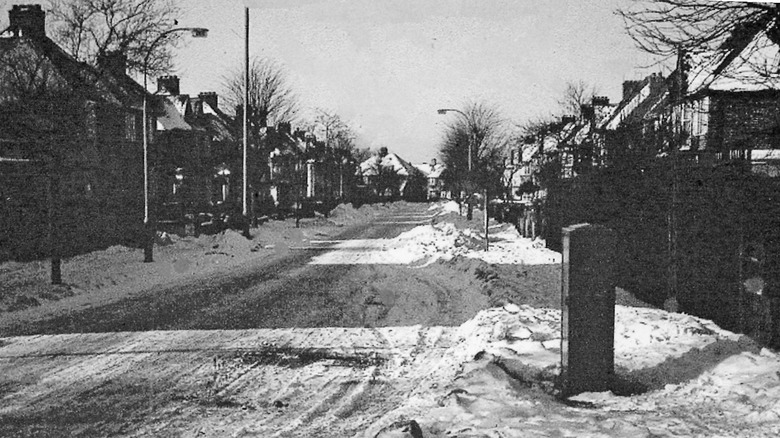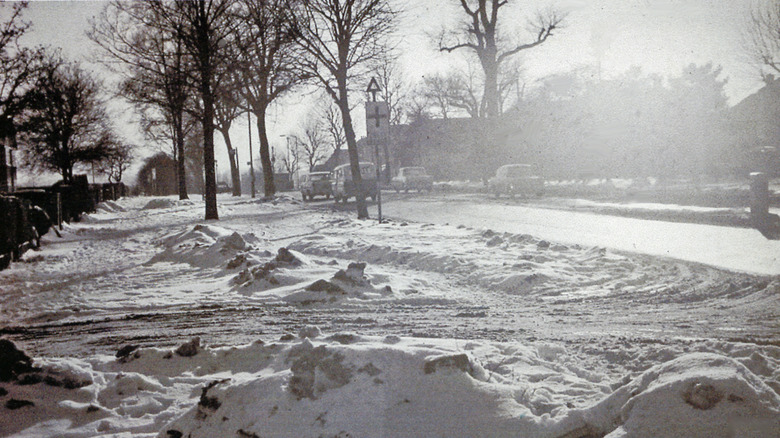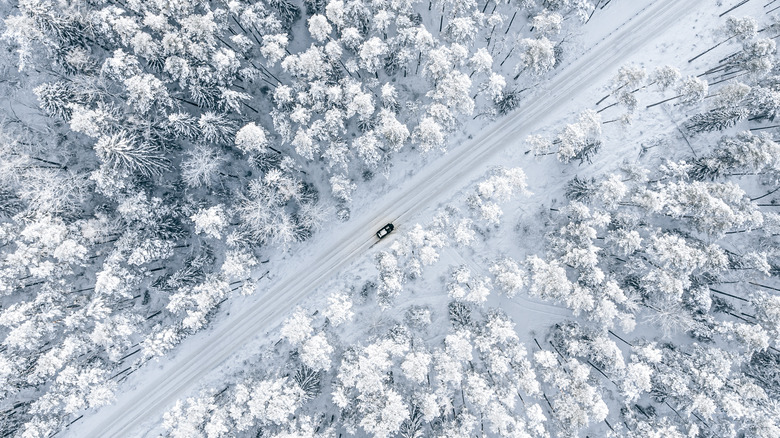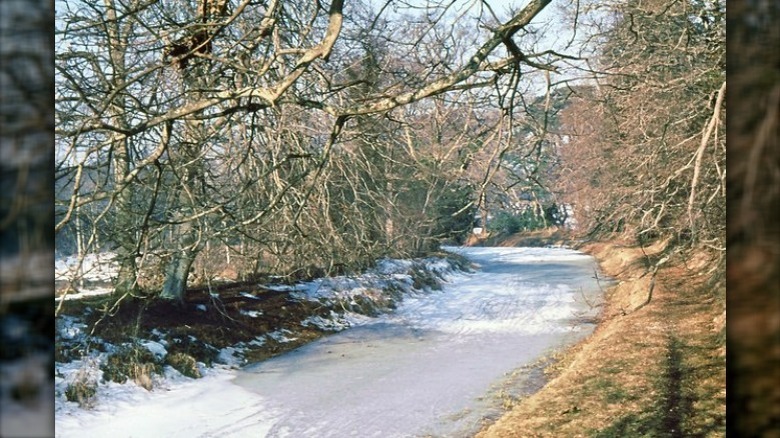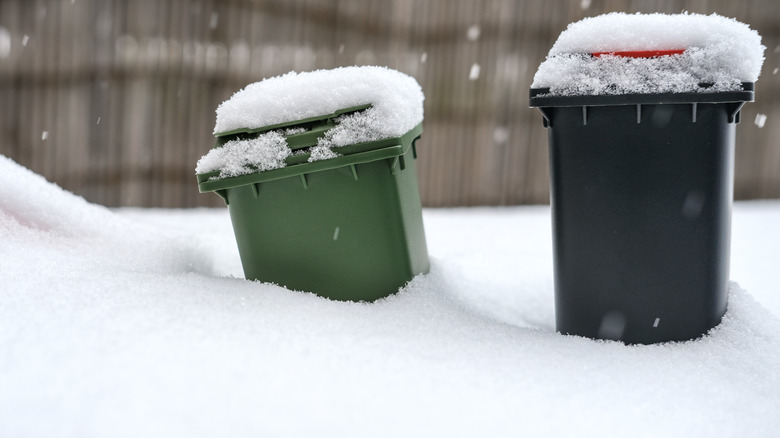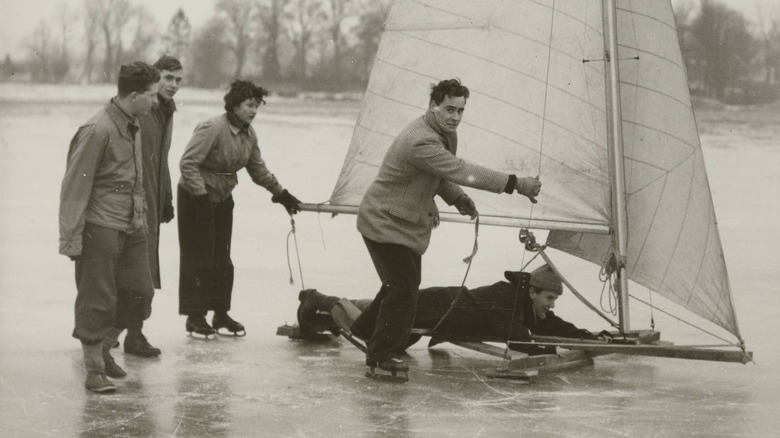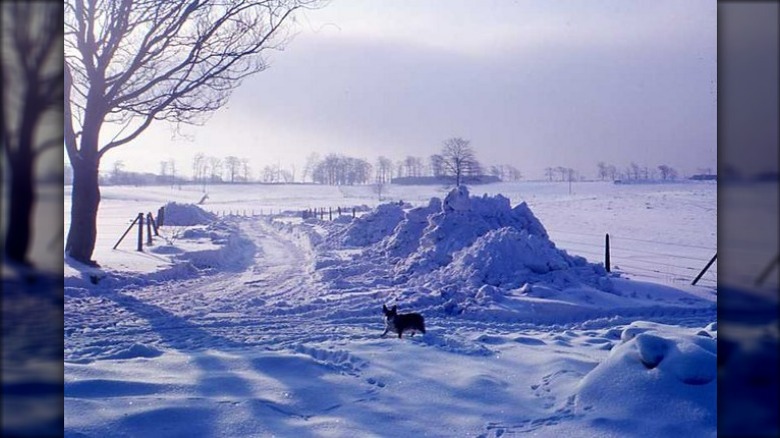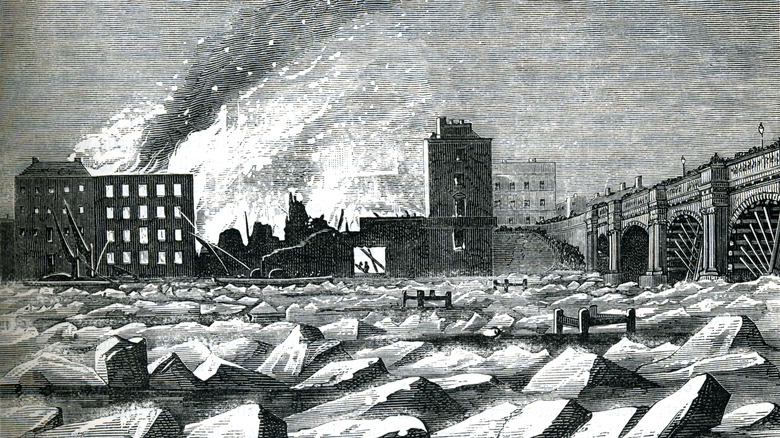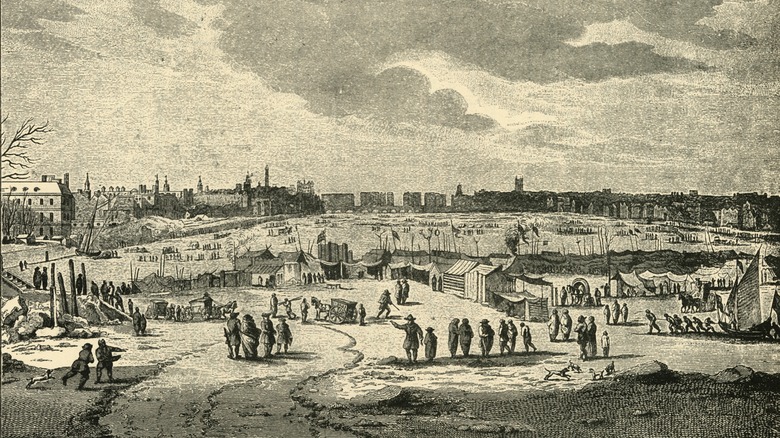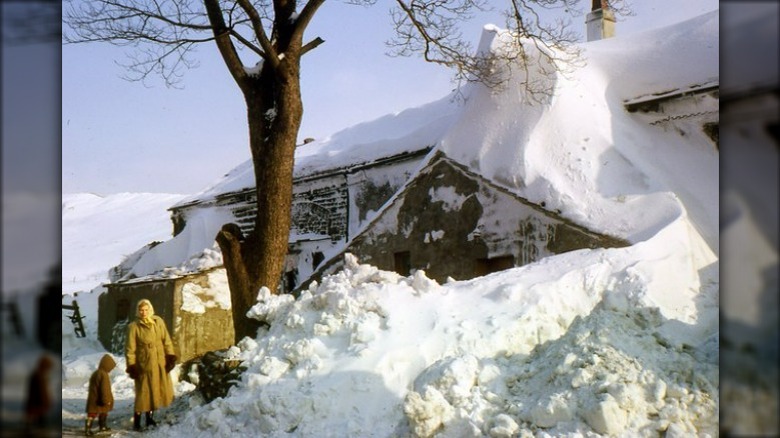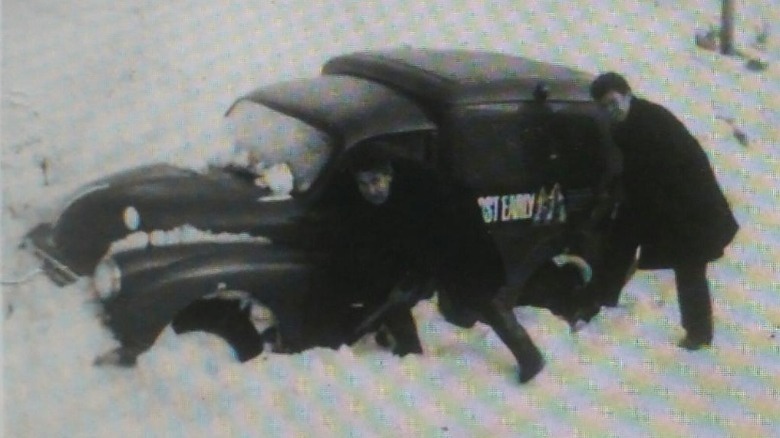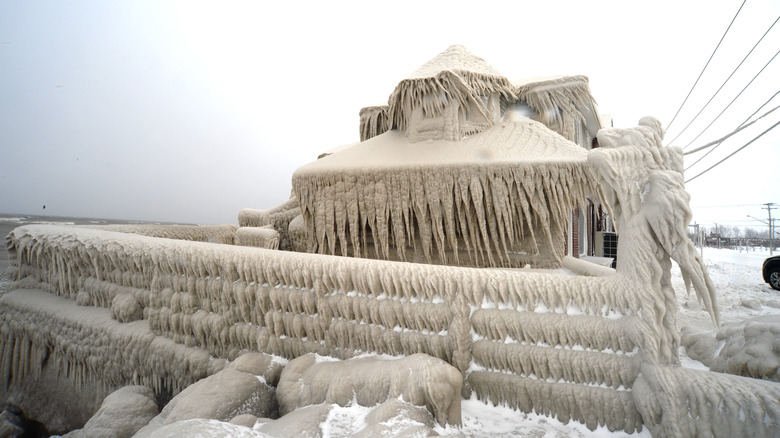A Look Back At The Big Freeze Of 1963
It was called "The Big Freeze of 1963" — even if it really did start in December of 1962 (via Radio Times). Around this time 60 years ago, Europe faced one of the longest and harshest cold fronts it had seen in over a century. Everyone hopes for a white Christmas — like the one that occurred that year in Glasgow, Scotland, for the first time since 1939 (via YouTube) — but this one was a bit of overkill, which lasted months. It started on Boxing Day, a holiday celebrated the day after Christmas by the United Kingdom and many current and former members of the Commonwealth.
That night, the United Kingdom saw the first snowfall of many that would occur over the next four months. On December 29 and 30, a major blizzard hit the region, with snow drifts up to 20 feet burying cars, streets, railways, sporting pitches, houses, and more. Still, this was only the start of what was yet to come. Rivers and sections of the sea froze, temperatures plummeted to averages of -20 degrees Celsius, and life changed as the Brits knew it for the next quarter of a year (via National World).
How the Big Freeze started
It was foggy, cold, and wet that first December, making way for a winter season blanketed in snow, unlike any the continent had seen since 1740 (via Radio Times). Frigid temperatures caused the River Thames and several other major waterways to freeze over. The sea outside Kent even froze over, up to a mile out from shore, National World reports. Some parts of the United Kingdom seemed as though they could become attached to the European mainland, with ice stretching over five miles out.
Other regions in Europe experience freezing temperatures more commonly — like parts of Germany, where winter temperatures regularly drop below 0 degrees Celsius (via Trip Savvy), and Ufa, Russia, where 19 degrees Fahrenheit on a winter day is considered warm, according to Weather Spark. As you might have guessed, in the United Kingdom, that is not the case. But the weather system that caused The Big Freeze of 1963 did not form above the United Kingdom at all — in fact, it came from a completely different part of the continent.
What caused the Big Freeze
The Big Freeze of 1963 was not caused by an average winter storm or blizzard. In fact, it was caused by an anticyclone (via Radio Times). Sounds scary, huh? Well, an anticyclone is a massive, high pressure, rotating wind system, according to Britannica; this one formed over Scandinavia, bringing an unforgiving cold front to the United Kingdom from central Russia. Unlike the United Kingdom, in some regions of Russia — particularly Siberia — winter temperatures can reach below -30 degrees Fahrenheit, making those -20 degrees Celsius (-4 degrees Fahrenheit) temperatures in the United Kingdom during The Big Freeze a bit more understandable (via The Weather Network).
On an average winter day, our friends over the pond would experience especially wet weather with mild temperatures that rarely fall below freezing, thanks to a humid winterly wind that blows in from the Atlantic Ocean. However, during The Big Freeze, that expected wind was blocked by high pressure systems over Iceland, which made way for much colder weather. Martin Strowger — a witness who lived near the Berkshire Downs in England that winter – remembered snow piles towering over not only him but cars (via BBC News). "I was only 7 at the time, and [the snow] seemed very high," he said. "Everywhere you went, it was snow pushed aside, walls of snow."
The environmental effects of the freeze
While those living in the United Kingdom during the winter of 1963 felt as if they themselves were freezing, most major waterways around them were actually freezing — even the big ones (via Radio Times). The River Thames is about 66 feet deep (via History) and 220 miles long, making it the longest river in all of England, and the second longest in the United Kingdom — second only to the River Severn in Wales, which is just four miles longer at 224 miles (via History).
It is safe to say freezing as thick as it did was an impressive feat, especially moving as rivers do. But what is more impressive is when moving salt water freezes. While most people know the freezing point for fresh water is 32 degrees Fahrenheit, the freezing point for saltwater is 28.4 (via National Ocean Service). The sea surrounding Kent stood no chance to the regular sub-freezing temperatures the region faced during this time (via National World), creating a broken block effect over the surface of the water due to tides rising and falling beneath the ice (via BBC).
The needs of those affected were not met
Snow squalls up to 20 feet blanketed the streets, making them nearly undrivable (let alone walkable), even to larger delivery vehicles (via National World). Winds in some areas of the United Kingdom reached over 50 miles per hour, while in the Isle of Man — an island in the Irish Sea between Great Britain and Ireland — it was over 100 miles per hour. Due to extreme inclement conditions, many societal services ceased to operate, so many peoples' needs were not met (via Radio Times).
Babies were obviously still being born, but it was difficult to reach anywhere by road, and not all midwives could make it to mothers. The ground was frozen solid, so anyone who died that winter could not be buried until the coming spring. Garbage was not being picked up, and goods could not be delivered — whether by the frozen canal via boat, impassable roads via truck, or railways via train. Some airports closed as well. Transportation was at a standstill — as was everyday life.
Some sports were canceled, while others emerged
Albeit seemingly less important than essential services — like garbage pick up, birth, or burying the dead — many professional athletes across various sports also ceased to play during The Big Freeze of 1963, as most arenas were buried in snow (via Radio Times). Matches to decide the FA (Football Association) Cup were delayed over a month, so the cup itself was delayed by four weeks. It's evident how passionate Europeans can be for soccer (a.k.a. football), as seen during any match of the World Cup, so one could only imagine how devastating this time was, for more reasons than those that seem the most obvious. Horse racing also suffered the wrath of The Big Freeze as tracks were blanketed and 94 race meetings were canceled; not a single horse race was held in England between December 23 and March 7. (It probably isn't fair for the poor animals to be running around in freezing temperatures anyway.)
But The Big Freeze was not bad for all activities. In fact, Britain became a destination for winter sports (via YouTube). People casually ice skated and ice yachted, while other professional sports matches were enabled to take place for the first time in years. The Grand Curling Match (a.k.a. The Bonspiel) took place for only the second time since 1935 on the frozen Lake Menteith in Scotland, with around 2,000 competitors. And in Lincolnshire, England, the Professional Ice Race Championship was made possible for the first time since 1959. Other sports went on as usual, like motorcycle scrambling, which was just made more exciting by the slippery, icy conditions.
A-not-so-cozy home
Prolonged exposure to the outside temperatures was certainly dangerous, but sadly, peoples' homes were not much safer (via Radio Times). The United Kingdom was not prepared for the severity of that winter, emotionally or structurally (via National World). Water pipes froze and burst, so people had to resort to filling buckets for drinking water; windows froze shut, creating fire hazards; telephone poles fell, limiting communication; and goods could not be delivered because the canals were frozen, and the railways and roads were treacherous. Due to this, nearly 15,000 homes in the United Kingdom went without milk deliveries that winter — not only because delivery drivers could not reach them, but if they did, the milk bottles would freeze to doorsteps and shatter.
The electric grid was also not equipped to deal with such high demand during the storm, so there was not enough electricity to go around — commercially or personally (via YouTube). Because of this, no home had full electrical power, lowering heating capabilities, so people turned to gas (via YouTube). They left their ovens open and running all day long to heat their homes, and soon — due to this and increased transportation needs — eventually gas ran short too. There wasn't enough gas for everyone, and soon, the coal began to run out as well.
Reactions to the Frozen Thames
At such low temperatures, it is no surprise all the surrounding water froze — whether it was in rivers, the sea, plumbing of homes, or in the famous fountain at Trafalgar Square in London (which regularly had icicles hanging from it). Southsea resident Wendy Stacey, who lived through The Big Freeze of 1963, said, "there were icicles hanging everywhere because it just didn't stop freezing," (via BBC). Like the massive River Thames in Southern London, other British rivers froze, including the River Dee, River Humber, and River Medway (via Radio Times).
Despite its all-too-dead appearance, The River Thames saw the most life above the rest. People went for strolls on it, rode bikes on it, and even held a car rally on it (via ITV). Some changed up their morning commutes to work, ice skating, or even driving their cars across waterways (via YouTube). They say you are supposed to make the most out of a bad situation, and those affected by such a devastating environmental change adapted. But it may have been because historically, periods plagued by plummeting temperatures in the United Kingdom were nothing new (via Nation).
Enjoying the frozen Thames had historical precedent
While the temperatures of The Big Freeze of 1963 might have surprised that generation, the River Thames freezing during particularly harsh winters throughout English history was nothing new, according to Science. Although modern winter days in the United Kingdom usually fall somewhere between 36 and 45 degrees Fahrenheit, it was not always that way (via British Council). In fact, the River Thames actually froze about 23 times since the 1300s — particularly during a period between the 14th and 19th centuries that was so cold, it was dubbed "The Little Ice Age."
During The Little Ice Age, society did not crumble the way it did during The Big Freeze (via the Radio Times). The community rejoiced during these winter seasons (via Historic U.K.). Between 1600 and 1814, England held massive carnivals called "Frost Fairs" on the frozen waterway, per Historic U.K. During these fairs, visitors could enjoy various sports like bowling, football, and racing; local plays, haircuts from skilled barbers, buy food and goods like fruit from vendors and chefs, shoes from shoemakers, and even take a break to cozy up by a fire in a tent. It was even said that King Charles II himself once spit-roasted a whole ox at one of the most famous Frost Fairs — the Blanket Fair of 1683-1684.
Evidently, the undying need to frolic in the snow at frigid temperatures was, in fact, an ancestral one for the Brits. During The Big Freeze, children and adults alike could be seen playing in the snow, having snowball fights, floating on dislodged ice chunks across waterways, and walking on frozen waves (via BBC News).
The Big Freeze caused tragic losses
Many were affected by the detrimental temperatures "The Big Freeze of 1963" brought on, but some were affected in the worst possible way. According to news reports from that year, about 120 people died throughout the duration of the freeze (via YouTube), however, more recent sources suggest there were much, much more. Excess winter deaths are exactly what they sound like — deaths that occur in excessive numbers, due to the burdens of winter weather (via Epidemiology). In 2019/2020, there were around 30,000 excess winter deaths in England and Wales (via Statista). To compare, the rate of excess winter deaths for the winter of 1962/1963 was around 89.6 thousand. As per YouTube, those most affected were the elderly — particularly those who lived alone and needed to fend for themselves in drastically cold temperatures — and babies, whose underdeveloped immune systems just could not handle it. Humans weren't the only ones to perish either — countless livestock, including sheep in the exposed countryside, died due to hunger and cold (via YouTube).
Albeit much less important than the loss of life, the United Kingdom saw ample financial losses as well (via YouTube). There were tens of thousands of pounds in losses, both in repairs and snow removal costs. The region also experienced intense flooding once all the snow began to melt, so the costly nature of the affair didn't just go away when the cold did (via YouTube).
A United Community in the United Kingdom
Those living in the United Kingdom during The Big Freeze of 1963 did a fair share of suffering together (via Radio Times). But they also played together — rallying cars and biking on the frozen rivers; playing in the snow and having snowball fights, and attempting to go on rides to enjoy the beautiful, snow-blanketed countryside (via BBC). Most importantly, they stood strong together — channeling that sense of community seen in the days of historic Frost Fairs. Despite it being difficult for midwives to reach expecting mothers, they still tried — helping each other push cars out of snow banks to reach the destinations where they were needed most. Milkmen still attempted to deliver milk, despite it freezing, and postmen still tried to deliver the mail. Community members even helped try to dig each other out of the snow and clear it from local roadways — one of them was Wendy Stacey from Southsea, England.
"Everybody worked together and kept it so that everybody could walk along safely," she said. Even during the frigid temperatures, she looks back at the time fondly and actually remembers sunny days despite everything. "The temperatures were awful considering it went on for so long, [but] when I think back, it was lovely sunny days, gloriously sunny days." And regardless of the societal standstill, she still remembers the community doing its best to function as if all was well. "I think about today, we struggle to get milk [during storms], but back in those days, everybody had the milkman."
Climate change means more major events like the Big Freeze
It's no surprise that the world's weather patterns are changing and becoming more extreme due to climate change. Scientific studies have proven that human effects on the environment will cause increased heat waves, cold fronts, and natural disasters (via the United States Environmental Protection Agency). In late December 2023, North America was blasted by a deadly, record-breaking cold front (via The Guardian), that covered some homes in Buffalo, New York in ice (pictured). At the same time, the United Kingdom was dealing with inclement weather treacherous enough to trigger Amber warnings (via U.K. Snow Updates on Twitter).
Streets around the world are seeing undrivable conditions, and temperature changes are growing more erratic. But we will — as they did then during The Little Ice Age (via Historic UK) and The Big Freeze of 1963 (via BBC) — continue to stand together; whether that means helping each other dig out of the wreckage like community members did in Florida after Hurricane Ian (via WTXL) — or enjoying it however we can, like kayaking in flood waters, or having snowball fights in blizzards.
